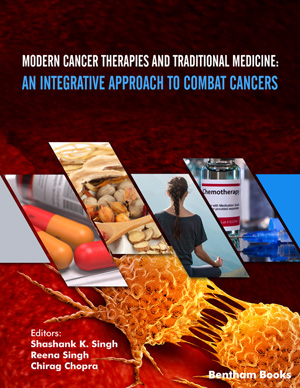
Abstract
Triple-negative breast cancer (TNBC) is a subtype of breast cancer that lacks receptors for targeted therapy. Consequently, chemotherapy is currently the mainstay of systemic treatment options. However, the enrichment of cancer stem cells (CSC, a subpopulation with stem-cell characteristics and tumor-initiating propensity) promotes chemo-resistance and tumorigenesis, resulting in cancer recurrence and relapse. Furthermore, toxic side effects of chemotherapeutics reduce patient wellbeing. Natural products specifically compounds derived from plants, have the potential to treat TNBC and target CSCs by inhibiting CSC signaling pathways. Literature evidence from six promising compounds was reviewed, including sulforaphane, curcumin, genistein, resveratrol, lycopene, and epigallocatechin-3-gallate. These compounds have been shown to promote cell cycle arrest and apoptosis in TNBC cells. They also could inhibit the epithelial-mesenchymal transition (EMT) that plays an important role in metastasis. In addition, those natural compounds have been found to inhibit pathways important for CSCs, such as NF-κB, PI3K/Akt/mTOR, Notch 1, Wnt/β- catenin, and YAP. Clinical trials conducted on these compounds have shown varying degrees of effectiveness. Epidemiological case-control studies for the compounds commonly consumed in certain human populations have also been summarized. While in vivo and in vitro data are promising, further basic and clinical investigations are required. Likely, natural products in combination with other drugs may hold great potential to improve TNBC treatment efficacy and patient outcomes.
Keywords: Breast cancer, triple-negative breast cancer, cancer stem cell, metastasis, apoptosis, natural compounds.
Graphical Abstract
[http://dx.doi.org/10.1038/modpathol.2010.200] [PMID: 21076464]
[http://dx.doi.org/10.1159/000455820] [PMID: 28611535]
[http://dx.doi.org/10.2217/pgs-2017-0117] [PMID: 29095114]
[http://dx.doi.org/10.1093/annonc/mdq279]
[http://dx.doi.org/10.1073/pnas.0530291100]
[http://dx.doi.org/10.1155/2018/5416923] [PMID: 29681949]
[http://dx.doi.org/10.1016/j.drup.2016.03.001] [PMID: 27180306]
[http://dx.doi.org/10.3390/cells5020016] [PMID: 27058560]
[PMID: 26175931]
[http://dx.doi.org/10.3390/cancers3022050] [PMID: 24212796]
[http://dx.doi.org/10.1002/1878-0261.12167] [PMID: 29316250]
[http://dx.doi.org/10.14348/molcells.2018.2242] [PMID: 29429151]
[http://dx.doi.org/10.3390/cells9081879] [PMID: 32796631]
[http://dx.doi.org/10.1186/bcr1610] [PMID: 17062128]
[http://dx.doi.org/10.18632/oncotarget.6920] [PMID: 26783961]
[http://dx.doi.org/10.4103/ctm.ctm_69_16] [PMID: 29276782]
[http://dx.doi.org/10.1016/j.ajpath.2013.06.012] [PMID: 22990110]
[http://dx.doi.org/10.3390/ijms20092272] [PMID: 31071959]
[http://dx.doi.org/10.1007/s11060-021-03702-0] [PMID: 33512631]
[http://dx.doi.org/10.21037/atm.2018.04.35] [PMID: 29911111]
[http://dx.doi.org/10.1038/84643] [PMID: 11175850]
[http://dx.doi.org/10.1023/B:CLIN.0000024761.00373.55] [PMID: 15168728]
[http://dx.doi.org/10.4103/0975-7406.155895] [PMID: 26015704]
[http://dx.doi.org/10.2174/138945006776054942] [PMID: 16515527]
[http://dx.doi.org/10.1155/2018/8324696] [PMID: 29681985]
[http://dx.doi.org/10.3390/molecules24193593] [PMID: 31590459]
[http://dx.doi.org/10.1111/j.1745-7254.2007.00679.x] [PMID: 17723168]
[http://dx.doi.org/10.1073/pnas.91.8.3147]
[http://dx.doi.org/10.1016/j.biopha.2019.109635] [PMID: 31739165]
[http://dx.doi.org/10.1158/1535-7163.MCT-06-0494] [PMID: 17339367]
[http://dx.doi.org/10.1038/s41419-018-0811-7] [PMID: 30050079]
[http://dx.doi.org/10.1038/cddis.2016.180] [PMID: 27362804]
[http://dx.doi.org/10.1038/onc.2015.293] [PMID: 26279303]
[http://dx.doi.org/10.1016/j.lfs.2018.10.034] [PMID: 30352240]
[http://dx.doi.org/10.1159/000439111] [PMID: 26372775]
[http://dx.doi.org/10.1007/s00394-013-0499-5] [PMID: 23389114]
[http://dx.doi.org/10.1016/j.bbrc.2012.09.006] [PMID: 22975350]
[PMID: 20944112]
[http://dx.doi.org/10.7150/thno.20657] [PMID: 28912888]
[http://dx.doi.org/10.1002/jcb.23386] [PMID: 21956685]
[http://dx.doi.org/10.1158/1940-6207.CAPR-18-0241] [PMID: 30679159]
[http://dx.doi.org/10.1158/1078-0432.CCR-09-2937] [PMID: 20388854]
[http://dx.doi.org/10.1016/j.breast.2012.07.013] [PMID: 22877795]
[http://dx.doi.org/10.1158/1940-6207.CAPR-15-0119] [PMID: 26511489]
[http://dx.doi.org/10.1017/S136898001500244X] [PMID: 26329135]
[http://dx.doi.org/10.1371/journal.pone.0140963] [PMID: 26524341]
[http://dx.doi.org/10.3390/foods6100092] [PMID: 29065496]
[http://dx.doi.org/10.2174/138945012804545632] [PMID: 23140290]
[http://dx.doi.org/10.1097/MCO.0000000000000598] [PMID: 31577640]
[http://dx.doi.org/10.1016/j.biopha.2016.05.037] [PMID: 27470399]
[http://dx.doi.org/10.1089/jmf.2016.3705]
[http://dx.doi.org/10.1016/j.jad.2014.06.001] [PMID: 25046624]
[http://dx.doi.org/10.3390/ijms20051033] [PMID: 30818786]
[http://dx.doi.org/10.1016/j.phymed.2009.04.008] [PMID: 19524420]
[http://dx.doi.org/10.3892/or.2012.2080] [PMID: 23076367]
[http://dx.doi.org/10.1158/1078-0432.CCR-05-1192] [PMID: 16243823]
[http://dx.doi.org/10.1111/j.1524-4741.2009.00709.x] [PMID: 19645775]
[http://dx.doi.org/10.1155/2015/878134] [PMID: 25879038]
[http://dx.doi.org/10.1016/j.cbi.2009.06.012] [PMID: 19573523]
[http://dx.doi.org/10.1097/CAD.0000000000000584] [PMID: 29356693]
[http://dx.doi.org/10.3390/cancers7030851] [PMID: 26270676]
[http://dx.doi.org/10.1186/s13045-017-0471-6] [PMID: 28476164]
[http://dx.doi.org/10.1016/j.phymed.2020.153312] [PMID: 32866906]
[http://dx.doi.org/10.1371/journal.pone.0158432] [PMID: 27348426]
[http://dx.doi.org/10.1016/j.phymed.2018.11.001] [PMID: 31005718]
[http://dx.doi.org/10.1021/jf404092f]
[http://dx.doi.org/10.4014/jmb.1801.01074] [PMID: 29642292]
[http://dx.doi.org/10.1371/journal.pone.0146553] [PMID: 26752181]
[http://dx.doi.org/10.3892/or.2016.4682] [PMID: 26985864]
[http://dx.doi.org/10.1186/s12935-014-0126-4] [PMID: 25530715]
[http://dx.doi.org/10.4196/kjpp.2013.17.4.291] [PMID: 23946688]
[http://dx.doi.org/10.3892/or.2018.6386] [PMID: 29693159]
[PMID: 25031701]
[http://dx.doi.org/10.1111/jcmm.15683] [PMID: 32725802]
[http://dx.doi.org/10.3892/mmr.2012.1103] [PMID: 23023821]
[http://dx.doi.org/10.2174/1871520615666150520093644] [PMID: 25991545]
[http://dx.doi.org/10.1002/ijc.10183] [PMID: 11857414]
[http://dx.doi.org/10.3390/ijms21239125] [PMID: 33266219]
[http://dx.doi.org/10.3389/fonc.2012.00161] [PMID: 23162792]
[http://dx.doi.org/10.3892/ijo.2019.4939] [PMID: 31894298]
[http://dx.doi.org/10.3390/molecules24142527] [PMID: 31295906]
[http://dx.doi.org/10.3892/or.2017.5593] [PMID: 28440434]
[http://dx.doi.org/10.1016/j.phymed.2020.153218] [PMID: 32335356]
[http://dx.doi.org/10.1055/s-0043-104633]
[http://dx.doi.org/10.1016/j.msec.2017.02.068] [PMID: 28415473]
[http://dx.doi.org/10.1021/mp700113r] [PMID: 17999464]
[http://dx.doi.org/10.1055/s-2006-957450] [PMID: 9619120]
[http://dx.doi.org/10.1158/1078-0432.CCR-04-0744] [PMID: 15501961]
[http://dx.doi.org/10.3390/molecules25061397] [PMID: 32204372]
[http://dx.doi.org/10.1007/978-981-13-7205-6_7]
[http://dx.doi.org/10.3390/ph12040161] [PMID: 31717764]
[http://dx.doi.org/10.18632/oncotarget.26302] [PMID: 30546830]
[http://dx.doi.org/10.1111/cas.14770] [PMID: 33316116]
[http://dx.doi.org/10.3390/molecules25194499] [PMID: 33008036]
[http://dx.doi.org/10.1186/s12906-019-2685-3] [PMID: 31638975]
[http://dx.doi.org/10.3945/an.114.008052] [PMID: 26178025]
[http://dx.doi.org/10.1016/j.bbamcr.2007.03.021] [PMID: 17490757]
[http://dx.doi.org/10.3892/ijmm.2012.990] [PMID: 22580499]
[http://dx.doi.org/10.1016/j.tiv.2008.08.001] [PMID: 18761399]
[http://dx.doi.org/10.1038/sj.onc.1206583] [PMID: 12879015]
[http://dx.doi.org/10.3892/ijo.2016.3351] [PMID: 26794366]
[http://dx.doi.org/10.1128/MCB.25.8.3364-3387.2005] [PMID: 15798220]
[http://dx.doi.org/10.1016/j.nutres.2011.01.011] [PMID: 21419318]
[http://dx.doi.org/10.3892/ijo.13.2.391] [PMID: 9664138]
[PMID: 9809990]
[http://dx.doi.org/10.5483/BMBRep.2006.39.4.448] [PMID: 16889690]
[http://dx.doi.org/10.1007/s10565-008-9054-1] [PMID: 18224451]
[http://dx.doi.org/10.1038/onc.2017.274] [PMID: 28783172]
[http://dx.doi.org/10.3892/ijo.2016.3327] [PMID: 26783066]
[http://dx.doi.org/10.3892/ijo.15.3.525] [PMID: 10427135]
[http://dx.doi.org/10.3892/ijo.26.4.1101] [PMID: 15754008]
[PMID: 9673352]
[http://dx.doi.org/10.3945/ajcn.2008.27361] [PMID: 19403632]
[http://dx.doi.org/10.1007/s10552-006-0062-2] [PMID: 17111256]
[http://dx.doi.org/10.1093/carcin/23.9.1491] [PMID: 12189192]
[http://dx.doi.org/10.1158/1055-9965.EPI-08-0405] [PMID: 19318430]
[http://dx.doi.org/10.1158/1940-6207.CAPR-11-0251] [PMID: 22307566]
[http://dx.doi.org/10.1097/00008469-200304000-00011] [PMID: 12671541]
[http://dx.doi.org/10.1093/jn/134.11.3089] [PMID: 15514280]
[http://dx.doi.org/10.1210/jc.84.11.4017] [PMID: 10566643]
[http://dx.doi.org/10.1007/BF03192335] [PMID: 12587954]
[http://dx.doi.org/10.2174/187152012803833107] [PMID: 22583407]
[http://dx.doi.org/10.1093/jn/129.2.399] [PMID: 10024618]
[http://dx.doi.org/10.1016/j.bbagen.2003.12.008]
[http://dx.doi.org/10.4161/cbt.11.10.15184] [PMID: 21389782]
[PMID: 30210672]
[http://dx.doi.org/10.1097/MCO.0b013e3282f0cef2] [PMID: 18089954]
[http://dx.doi.org/10.1016/j.semcancer.2015.11.001] [PMID: 26774195]
[http://dx.doi.org/10.1016/j.jsbmb.2019.03.001] [PMID: 30851384]
[http://dx.doi.org/10.3390/molecules24061131] [PMID: 30901941]
[http://dx.doi.org/10.1002/iub.1749] [PMID: 29637742]
[http://dx.doi.org/10.3892/ijo.2018.4512] [PMID: 30066852]
[http://dx.doi.org/10.3109/10715762.2012.671940] [PMID: 22571807]
[http://dx.doi.org/10.1002/ijc.20856] [PMID: 15688415]
[http://dx.doi.org/10.1038/emm.2016.151] [PMID: 28232662]
[http://dx.doi.org/10.1016/j.rvsc.2020.07.017] [PMID: 32745729]
[http://dx.doi.org/10.1016/j.biocel.2019.05.020] [PMID: 31173924]
[http://dx.doi.org/10.18632/oncotarget.25631] [PMID: 30018739]
[http://dx.doi.org/10.1097/01.cej.0000228413.06471.4c] [PMID: 17554206]
[http://dx.doi.org/10.1016/j.canlet.2006.08.013] [PMID: 16996206]
[http://dx.doi.org/10.1096/fj.03-0292fje] [PMID: 14563682]
[http://dx.doi.org/10.1093/oxfordjournals.bmb.a011629] [PMID: 9374036]
[http://dx.doi.org/10.1080/15216540600871118] [PMID: 16916783]
[http://dx.doi.org/10.1002/mnfr.201801239] [PMID: 30690879]
[http://dx.doi.org/10.3892/etm.2015.2895] [PMID: 26889234]
[http://dx.doi.org/10.1006/bbrc.2000.2750] [PMID: 10872829]
[http://dx.doi.org/10.1016/j.phrs.2012.08.001] [PMID: 22906730]
[http://dx.doi.org/10.1155/2015/837042]
[http://dx.doi.org/10.2174/1389557519666190128093840] [PMID: 30686253]
[http://dx.doi.org/10.3892/or.2019.7122] [PMID: 31002359]
[http://dx.doi.org/10.3892/ijo.2017.4058]
[http://dx.doi.org/10.1039/C9FO00580C] [PMID: 31120074]
[http://dx.doi.org/10.1177/153537020222701013]
[http://dx.doi.org/10.1007/s10549-006-9405-7] [PMID: 17051425]
[http://dx.doi.org/10.1146/annurev.food.102308.124120] [PMID: 22129335]
[http://dx.doi.org/10.1007/s13277-016-4798-3] [PMID: 26779636]
[http://dx.doi.org/10.1111/cas.12349] [PMID: 24397737]
[PMID: 24596385]
[http://dx.doi.org/10.2217/14622416.7.5.663] [PMID: 16886892]
[http://dx.doi.org/10.1002/em.20363] [PMID: 18181168]
[http://dx.doi.org/10.1080/01635581.2011.606955] [PMID: 21958026]
[http://dx.doi.org/10.3390/nu4111679] [PMID: 23201840]
[http://dx.doi.org/10.1155/2017/5615647] [PMID: 28884125]
[http://dx.doi.org/10.1007/s00432-017-2515-2] [PMID: 28942499]
[http://dx.doi.org/10.1074/jbc.M513378200] [PMID: 16495219]
[http://dx.doi.org/10.3892/ol.2017.6108] [PMID: 28693189]
[http://dx.doi.org/10.1097/CAD.0b013e32833a4385] [PMID: 20527725]
[http://dx.doi.org/10.3390/nu12041042] [PMID: 32290071]
[http://dx.doi.org/10.1186/1471-2407-13-421] [PMID: 24044575]
[http://dx.doi.org/10.1016/j.bmc.2012.03.002] [PMID: 22459208]
[http://dx.doi.org/10.1007/s10549-007-9678-5] [PMID: 17902053]
[PMID: 26254344]
[http://dx.doi.org/10.3390/molecules24162899] [PMID: 31404982]
[http://dx.doi.org/10.1007/s00432-013-1376-6] [PMID: 23354842]
[http://dx.doi.org/10.1371/journal.pone.0073464] [PMID: 24039951]
[http://dx.doi.org/10.1093/jn/132.8.2307] [PMID: 12163680]
[http://dx.doi.org/10.1038/84635] [PMID: 11175849]
[http://dx.doi.org/10.18632/oncotarget.1932] [PMID: 24811362]
[http://dx.doi.org/10.1158/1940-6207.CAPR-17-0187] [PMID: 28904061]
[http://dx.doi.org/10.1055/s-0032-1315129] [PMID: 25258465]
[http://dx.doi.org/10.2174/156652412798889063] [PMID: 22280355]
[http://dx.doi.org/10.1002/ijc.11259] [PMID: 12845655]
[http://dx.doi.org/10.1016/j.canep.2015.11.013] [PMID: 26680603]
[http://dx.doi.org/10.1016/j.chemphyslip.2019.04.005] [PMID: 30965023]
[http://dx.doi.org/10.1016/j.chemphyslip.2016.05.006] [PMID: 27234272]
[http://dx.doi.org/10.1016/j.ijpharm.2020.119449] [PMID: 32464231]
[http://dx.doi.org/10.1002/ptr.6154] [PMID: 30009577]
[http://dx.doi.org/10.3390/molecules24061027] [PMID: 30875891]
[http://dx.doi.org/10.1158/0008-5472.CAN-06-4699] [PMID: 17483343]
[http://dx.doi.org/10.1016/j.biocel.2015.07.009] [PMID: 26212257]
[http://dx.doi.org/10.1007/s11101-019-09628-w]
























